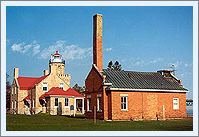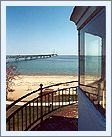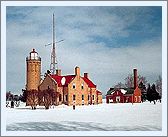 |
 |
 |
 |
| Click on thumbnails to view enlarged versions | |||
| Old Mackinac Point Light | Seeing The Light |
|
|
|
|
Historical
Information
Maritime traffic expanded rapidly through the lakes in a westerly direction during the first half of the nineteenth century, and responsibility for navigational aids fell under Stephen Pleasonton, the Fifth Auditor of the Treasury. Unfortunately, Pleasonton’s experience was purely in the area of fiscal administration, and having no background in maritime matters, his administration was characterized by slow reaction and the choosing of "least cost" alternatives. With large vessel traffic increasing from Lake Huron into the Straits, the first step in guarding the Straits was taken in 1829, through the construction of Bois Blanc Island Lighthouse to both guide mariners in making the turn into the Straits, and to warn them of the shoals and shallows surrounding the island. Three years later in 1832, Congress acted on the Fifth Auditor’s recommendation that a lightship be placed on Waugoshance Shoal as the first attempt to mark the western entrance to the Straits. However, in typical Pleasonton fashion, the decision was made to convert the wooden vessel LOIS MCLANE into a light vessel rather than spend the money necessary to build a more suitable purpose-designed vessel. Nonetheless, the commissioning of the Lois McLane marked a historical point in inland navigation history, being the first light vessel to serve on any of the Great Lakes.
Homans recommended that a new, and more suitable lightship be constructed for use on Waugoshance Shoal, and that the existing vessel be transferred for use in the more sheltered confines of Lake St. Clair. In that same report, Homans strongly recommended that a lighthouse be constructed on "the point to the west of Mackinaw harbor." While he did not specifically refer to Old Mackinac Point, it would appear that it was indeed that point to which he was referring when he continued "the narrowest part of the strait is opposite this point; of course increases the dangers to the navigation just there, especially in the night." Pleasonton took no action on Homans recommendations. Though new light stations were constructed to guard both eastern and western entrances to the Straits, and while thirty-nine vessels went down in the Straits in the interim, the treacherous Straits of Mackinac themselves remained unmarked for the following thirty-one years. Administration of aids to navigation was transferred to the nine member Lighthouse Board in 1852, and with this change attention was once again focused on the Straits. Ignoring local petitions for the construction of a light on Old Mackinac Point, in 1854 the Board recommended that an appropriation of $6,000 be made for the construction McGulpin’s Point Light Station, approximately three miles to the west of Old Mackinac Point. The Lighthouse Board renewed its recommendation every year thereafter, however Congress did not appropriate the necessary funds until July 26, 1866. Work began at McGulpin’s Point in the Spring of 1869, with the station’s Third and a Half Order Fresnel lens exhibited for the first time that fall.
Finally coming to the realization that Old Mackinac Point’s central location within the Straits was also a far better location for a first-class shore light than at McGulpin’s Point, the Board also petitioned Congress for $25,000 for the construction of a light station to augment the fog signal, suggesting that with the construction of such a facility, the McGulpin’s Point station could be declared obsolete and closed down. In the act of March 2, 1889 Congress responded favorably to both recommendations, however an appropriation was only made for the $5,500 cost of constructing the fog signal, and none for the construction of the requested light station.
Contracts were issued for the fog-signal equipment and building materials, with some of them delivered to the point late in 1889. Work began on the station on July 1, 1890, and continued through the summer. With the structure’s completion, the wood-framed building stood 22 feet by 40 feet, sheathed on the exterior with corrugated iron and smooth iron sheets on its interior. Its twin ten-inch steam whistles were powered by a pair of boilers, set on brick foundations. Work finished on October 9, 1890, and the signals were officially placed into operation on November 5 of that same year. Over the next year of use, the station’s twin steam whistles would be operated for a total of 300 hours, with the boilers consuming 10 tons of bituminous coal and 18 cords of firewood.
The lighthouse tender Amaranth delivered the necessary supplies and Schmitt's work party at the Point in the latter part of May, and work on the station began in earnest. On a foundation of ashlar limestone, the tower and attached keeper’s dwelling were both constructed of Cream City brick, trimmed with Indiana limestone. The double-walled tower was laid with an outside diameter of 13 feet 4 inches, and as each course was added, rose to a height of 45 feet, surmounted by a circular iron gallery and an 8 foot 8 inch diameter watch room, which was in-turn capped by a prefabricated octagonal iron lantern.
The station complex was completed with a 16 foot by 24 foot storehouse, a wooden barn, and a circular iron oil storage building with a total capacity of 360 gallons of kerosene in standard Lighthouse Board five gallon containers. The district lampist arrived at the station and installed and adjusted the station’s red Fourth Order Fresnel lens to ensure that it met the specification of a fixed red light varied by a red flash every ten seconds. Keeper George W. Marshall displayed the light for the first time on October 25, 1892, and with their work complete, the tender Amaranth arrived at the Point and removed the work party on October 27.
When the Mackinac Bridge opened in 1957, the car ferries were out of business, and with the brightly illuminated bridge serving as a navigation aid par excellence, the old light station was immediately rendered obsolete and was decommissioned. The property was acquired by Mackinac State Historic Parks in 1960, and the station was operated as a maritime museum from for 1972 through 1988, but was subsequently closed.
At the end of 2003, work on the roof had been completed, and the windows stripped and boarded-up. Work will continue into the Spring of 2004, with a grand reopening of the station planned for June 12, 2004. Work on the station will not be complete at the reopening, but visitors will be allowed to tour the structure to view the work in process. When work on the station is complete, plans call for re-erecting the station barn and installing the wooden picket fence which surrounded the station grounds in the early 1900's.
Situated majestically at the northernmost point of Michigan's lower peninsula, the Lighthouse Board knew exactly what they were doing when they placed the station, since even today it offers a commanding view of maritime traffic passing through and across the Straits. MSHP plans to open the lighthouse to the public on June 12, with a Grand Opening ceremony planned for June 26. The gift shop in the fog signal building is expected to be open on a daily basis from May 12th through October 14th, with hours from 9 a.m. to 5 p.m. To make a donation to help with the restoration, contact: Mackinac Associates |